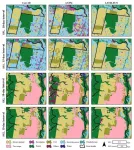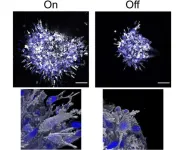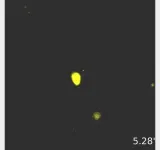(Press-News.org) Quantum dots are a kind of artificial atom: just a few nanometres in size and made of semiconductor materials, they can emit light of a specific colour or even single photons, which is important for quantum technologies. The discoverers and pioneers of the commercial production of quantum dots were awarded the Nobel Prize in Chemistry in 2023. In recent years, quantum dots made of perovskites have attracted particular attention. Perovskites belong to a class of materials that have a similar structure to the mineral perovskite (calcium titanate).Quantum dots made of such materials were produced for the first time by ETH Zurich in 2015. These Quantum dots made of perovskite nanocrystals can be mixed with liquids to form a dispersion, which makes them easy to process further. Moreover, their special optical properties make them shine more brightly than many other quantum dots. They can also be produced more cheaply, which makes them interesting for applications in displays, for instance.
A team of researchers led by Maksym Kovalenko at ETH Zurich and Empa, working in collaboration with their counterparts in Ukraine and the USA, have now demonstrated how these promising properties of perovskite quantum dots can be improved further. They used chemical methods for surface treatment and quantum mechanical effects that had never before been observed in perovskite quantum dots. The researchers recently published their results in two papers in the prestigious scientific journal Nature.
Unhappy atoms reduce brightness
Brightness is an important measure for quantum dots and is related to the number of photons the quantum dot emits per second. Quantum dots radiate photons of a specific colour (and hence frequency) after being excited, for example, by ultraviolet light of a higher frequency. This leads to the formation of an exciton consisting of an electron, which can now move more freely, and a hole – in other words, a missing electron – in the energetic band structure of the material. The excited electron can fall back to a lower energy state and thus recombine with the hole. If the energy released during this process is converted into a photon, the quantum dot emits light.
This doesn’t always work, however. “At the surface of the perovskite nanocrystals are ‘unhappy’ atoms that are missing a neighbour in the crystal lattice,” senior researcher Gabriele Raino explains. These edge atoms disturb the balance between positive and negative charge carriers inside the nanocrystal and can cause the energy released during a recombination to be converted into lattice vibrations instead of being emitted as light. As a result, the quantum dot “blinks”, meaning that it doesn’t shine continuously.
Protective coating made of phospholipids
To prevent this from happening, Kovalenko and his team have developed tailor-made molecules known as phospholipids. “These phospholipids are very similar to the liposomes in which, for instance, the mRNA vaccine against the coronavirus is embedded in such a way as to make it stable in the bloodstream until it reaches the cells,” Kovalenko explains. An important difference: the researchers optimised their molecules so that the polar, or electrically sensitive, part of the molecule latches on to the surface of the perovskite quantum dots and makes sure that the ‘unhappy’ atoms are provided with a charge partner.
The nonpolar part of the phospholipid that protrudes on the outside also makes it possible to turn quantum dots into a dispersion inside non-aqueous solutions such as organic solvents. The lipid coating on the surface of the perovskite nanocrystals is also important for their structural stability, as Kovalenko emphasises: “This surface treatment is absolutely essentially for anything we might want to do with the quantum dots.” So far, Kovalenko and his team have demonstrated the treatment for quantum dots made of lead halide perovskites, but it can also be easily adapted to other metal halide quantum dots.
Even brighter thanks to superradiance
With the lipid surface it was possible to reduce the blinking of the quantum dots to such an extent to emit a photon in 95 percent of electron-hole recombination events. To make the quantum dot even brighter, however, the researchers had to increase the speed of the recombination itself – and that requires quantum mechanics. An excited state, such as an exciton, decays when a dipole – positive and negative charges displace with respect to each other – interacts with the electromagnetic field of the vacuum. The larger the dipole, the faster the decay. One possibility of creating a larger dipole involves coherently coupling several smaller dipoles to each other. This can be compared to pendulum clocks that are mechanically connected and tick in step with each other after a certain length of time.
The researchers were able to show experimentally that the coherent coupling also works in perovskite quantum dots – with only a single exciton dipole that, through quantum mechanical effects, spreads out all over the volume of the quantum dot, thereby creating several copies of itself, as it were. The larger the quantum dot, the more copies can be created. These copies can bring about an effect known as superradiance, by which the exciton recombines much faster. The quantum dot is consequently also ready more quickly to take up a new exciton and can thus emit more photons per second, making it even brighter. An important detail to note is that the faster quantum dot continues to emit single photons (not several photons at once), which makes it suitable for quantum technologies.
The improved perovskite quantum dots are not only of interest for light production and displays, says Kovalenko, but also in other, less obvious fields. For instance, they could be used as light-activated catalysts in organic chemistry. Kovalenko is conducting research into such applications and several others, including within the framework of NCCR Catalysis.
END
How to make bright quantum dots even brighter
2024-01-31
ELSE PRESS RELEASES FROM THIS DATE:
Method combines artificial intelligence and satellite imagery to map crop-livestock integration systems
2024-01-31
Crop-livestock integration (CLI) systems combine the growing of crops in rotation or consortium, especially grain crops such as soybeans, corn and sorghum, and forage plants used to feed cattle and pigs, with the raising of livestock, typically beef cattle. The crops provide most of the cash income, while the livestock has food available during the dry season and facilitates seed management. CLI improves soil fertility, raises yields and helps rehabilitate degraded areas while reducing the use of pesticides, mitigating the risk of erosion and the seasonality of production, and lowering ...
Pedestrian injuries from falls versus motor vehicle collisions: are we lacking critical policy and interventions?
2024-01-31
January 31, 2024—Using Emergency Medical Services (EMS) data, researchers at Columbia University Mailman School of Public Health compared the national burden of pedestrian injuries from motor vehicles to that of pedestrian falls occurring on streets and sidewalks and found that the probability of a pedestrian suffering a severe injury is higher for motor vehicle collisions as compared to falls. Yet, the public health burden of the number of pedestrians injured from a fall – severe or otherwise - is significantly higher compared to the number of pedestrians injured by a motor ...
Treatment of aggressive breast cancer: discovery of a new protein involved in the development of metastases
2024-01-31
A protein found abundantly in breast cancers that are refractory to conventional treatments is thought to cause the development of metastasis. Targeting it would prevent metastatic spread and therefore increase patients survival. These are the findings of a study conducted by a French-American team and led by a biologist at CNRS1. The study, the results of which appear on 31st January in Cell Discovery, aims to better understand the mechanisms at play in the development of primary tumours in aggressive ...
Worldwide prevalence and disability from mental disorders across childhood and adolescence
2024-01-31
About The Study: In this analysis using data from the 2019 Global Burden of Disease study, there was a high prevalence of mental disorders affecting children and youths, indicating that more than 1 of 10 (or 293 million) individuals ages 5 to 24 globally live with a diagnosable mental disorder. In terms of burden, around one-fifth of all disease-related disability (considering all causes) was attributable to mental disorders among this population. Additionally, this age period encompasses about one-fourth of the mental disorder burden across the entire life course.
Authors: Christian Kieling, M.D., Ph.D., of the Universidade ...
1 of 10 veterans diagnosed with dementia may instead have cognitive decline from cirrhosis
2024-01-31
RICHMOND, Va. (Jan. 31, 2024) – As many as 10% of older U.S. veterans diagnosed with dementia may suffer instead from reversible cognitive decline caused by advanced liver disease, according to an analysis from the Virginia Commonwealth University’s School of Medicine and the Richmond VA Medical Center.
It can be difficult for physicians to differentiate dementia from the cognitive decline caused by cirrhosis, called hepatic encephalopathy. If undetected, patients may not receive appropriate treatment that can reverse or halt the impairment. ...
Leisure-time physical activity and falls with and without injuries among older women
2024-01-31
About The Study: Participation in leisure-time physical activity at the recommended level or above was associated with lower odds of both non-injurious and injurious falls in this study of 7,100 older women. Brisk walking and both moderate and moderate-vigorous leisure-time physical activity were associated with lower odds of non-injurious falls.
Authors: Wing S. Kwok, B.App.Sc., of the University of Sydney in Sydney, Australia, is the corresponding author.
To access the embargoed study: Visit our For The Media website ...
Oxford scientists launch ambitious roadmap for circular carbon plastics economy
2024-01-31
Researchers from the Oxford Martin Programme on the Future of Plastics, University of Oxford, have outlined ambitious targets to help deliver a sustainable and net zero plastic economy. In a paper published in Nature, the authors argue for a rethinking of the technical, economic, and policy paradigms that have entrenched the status-quo, one of rising carbon emissions and uncontrolled pollution.
Currently the global plastics system results in over 1 gigatonnes per annum (Gt/annum) of carbon dioxide equivalent emissions which is the same as the total combined emissions ...
Molecule can quickly, and briefly, boost white blood cell counts
2024-01-31
New Haven, Conn. — Treatment with a molecule known as A485 can quickly and temporarily increase levels of white blood cells, a critical part of the body’s immune system, an effect that is difficult to deliver with currently available pharmaceuticals, a new Yale study finds.
In an experiment, the researchers found that exposure to the molecule in mice caused white blood cells to mobilize from the bone marrow, a response that could inform future treatment for patients who need a boost in immune activity, the researchers say.
The findings were reported Jan. 31 in the journal ...
When and how immune cells decide to form pathogen memories
2024-01-31
Unexpected findings have emerged about how and when certain infection-killing white blood cells decide to form memories about their encounters with a pathogen.
It has been known for decades that these cells can turn themselves into durable memory cells that can survive a long time after an initial infection is cleared. They are prepared to quickly recognize and eliminate future intrusions by the same kind of pathogen.
That is one reason people are resistant to some infectious diseases after exposure to or recovery from the illness. Vaccinations also work this ...
Whole blood transfusion improves survival during traumatic bleeding
2024-01-31
(Boston)—Significant bleeding due to traumatic injury is the number one cause of preventable deaths in the U.S., with the majority of deaths occurring within six hours. Emerging evidence suggests that the transfusion of whole blood (blood that is not separated into parts) is associated with a survival benefit compared to the traditional use of blood component transfusion (red blood cells, plasma, and platelets) in these patients.
A new study from researchers from Boston University Chobanian & Avedisian School of ...


